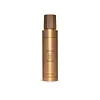What's inside
What's inside
 Key Ingredients
Key Ingredients

No key ingredients
 Benefits
Benefits

 Concerns
Concerns

 Ingredients Side-by-side
Ingredients Side-by-side

Water
Skin ConditioningPropanediol
SolventIsobutane
Propane
Glycerin
HumectantPanthenol
Skin ConditioningArginine
MaskingSerine
MaskingAlanine
MaskingGlycine
BufferingThreonine
Proline
Skin ConditioningValine
MaskingHistidine
HumectantIsoleucine
Skin ConditioningPhenylalanine
MaskingAspartic Acid
MaskingPCA
HumectantOryza Sativa Seed Protein
AntioxidantPolyquaternium-4
Polyquaternium-11
Polyquaternium-73
Oryza Sativa Extract
AbsorbentSalix Nigra Bark Extract
Skin ProtectingSodium Surfactin
CleansingHydrolyzed Pea Protein
EmollientHydrolyzed Soy Protein
HumectantCalcium Gluconate
HumectantHydrolyzed Amaranth Protein
Skin ConditioningGlyceryl Caprylate
EmollientSodium Lactate
BufferingOctyldodecyl Ricinoleate
EmollientPolyglyceryl-6 Oleate
EmulsifyingCetrimonium Chloride
AntimicrobialCaprylyl/Capryl Glucoside
CleansingSodium Cocoyl Glutamate
CleansingCocamidopropyl Betaine
CleansingButylene Glycol
HumectantPhytic Acid
Gluconolactone
Skin ConditioningTetrasodium Glutamate Diacetate
Phenoxyethanol
PreservativeEthylhexylglycerin
Skin ConditioningCitric Acid
BufferingParfum
MaskingWater, Propanediol, Isobutane, Propane, Glycerin, Panthenol, Arginine, Serine, Alanine, Glycine, Threonine, Proline, Valine, Histidine, Isoleucine, Phenylalanine, Aspartic Acid, PCA, Oryza Sativa Seed Protein, Polyquaternium-4, Polyquaternium-11, Polyquaternium-73, Oryza Sativa Extract, Salix Nigra Bark Extract, Sodium Surfactin, Hydrolyzed Pea Protein, Hydrolyzed Soy Protein, Calcium Gluconate, Hydrolyzed Amaranth Protein, Glyceryl Caprylate, Sodium Lactate, Octyldodecyl Ricinoleate, Polyglyceryl-6 Oleate, Cetrimonium Chloride, Caprylyl/Capryl Glucoside, Sodium Cocoyl Glutamate, Cocamidopropyl Betaine, Butylene Glycol, Phytic Acid, Gluconolactone, Tetrasodium Glutamate Diacetate, Phenoxyethanol, Ethylhexylglycerin, Citric Acid, Parfum
Ingredients Explained
These ingredients are found in both products.
Ingredients higher up in an ingredient list are typically present in a larger amount.
Cocamidopropyl Betaine is a fatty acid created by mixing similar compounds in coconut oil and dimethylaminopropylamine, a compound with two amino groups.
This ingredient is a surfactant and cleanser. It helps gather the dirt, pollutants, and other impurities in your skin to be washed away. It also helps thicken a product and make the texture more creamy.
Being created from coconut oil means Cocamidopropyl Betaine is hydrating for the skin.
While Cocamidopropyl Betaine was believed to be an allergen, a study from 2012 disproved this. It found two compounds in unpure Cocamidopropyl Betaine to be the irritants: aminoamide and 3-dimethylaminopropylamine. High-grade and pure Cocamidopropyl Betaine did not induce allergic reactions during this study.
Learn more about Cocamidopropyl BetaineGlycerin is already naturally found in your skin. It helps moisturize and protect your skin.
A study from 2016 found glycerin to be more effective as a humectant than AHAs and hyaluronic acid.
As a humectant, it helps the skin stay hydrated by pulling moisture to your skin. The low molecular weight of glycerin allows it to pull moisture into the deeper layers of your skin.
Hydrated skin improves your skin barrier; Your skin barrier helps protect against irritants and bacteria.
Glycerin has also been found to have antimicrobial and antiviral properties. Due to these properties, glycerin is often used in wound and burn treatments.
In cosmetics, glycerin is usually derived from plants such as soybean or palm. However, it can also be sourced from animals, such as tallow or animal fat.
This ingredient is organic, colorless, odorless, and non-toxic.
Glycerin is the name for this ingredient in American English. British English uses Glycerol/Glycerine.
Learn more about GlycerinHydrolyzed Soy Protein is a vegan protein made to mimic hydrolyzed collagen. It is created from soy, or glycine soja.
This ingredient is a humectant, meaning it helps hydrate the skin by binding to water. According to a manufacturer, it is also a great hair conditioner.
Read more about hydrolyzed collagen here.
Learn more about Hydrolyzed Soy ProteinWe don't have a description for Isobutane yet.
Parfum is a catch-all term for an ingredient or more that is used to give a scent to products.
Also called "fragrance", this ingredient can be a blend of hundreds of chemicals or plant oils. This means every product with "fragrance" or "parfum" in the ingredients list is a different mixture.
For instance, Habanolide is a proprietary trade name for a specific aroma chemical. When used as a fragrance ingredient in cosmetics, most aroma chemicals fall under the broad labeling category of “FRAGRANCE” or “PARFUM” according to EU and US regulations.
The term 'parfum' or 'fragrance' is not regulated in many countries. In many cases, it is up to the brand to define this term.
For instance, many brands choose to label themselves as "fragrance-free" because they are not using synthetic fragrances. However, their products may still contain ingredients such as essential oils that are considered a fragrance by INCI standards.
One example is Calendula flower extract. Calendula is an essential oil that still imparts a scent or 'fragrance'.
Depending on the blend, the ingredients in the mixture can cause allergies and sensitivities on the skin. Some ingredients that are known EU allergens include linalool and citronellol.
Parfum can also be used to mask or cover an unpleasant scent.
The bottom line is: not all fragrances/parfum/ingredients are created equally. If you are worried about fragrances, we recommend taking a closer look at an ingredient. And of course, we always recommend speaking with a professional.
Learn more about ParfumWe don't have a description for Polyquaternium-4 yet.
Propane is a gas derived from petroleum and natural gas. It is used as a propellant.
This ingredient is most commonly used in shaving cream, hair products, and makeup.
Water. It's the most common cosmetic ingredient of all. You'll usually see it at the top of ingredient lists, meaning that it makes up the largest part of the product.
So why is it so popular? Water most often acts as a solvent - this means that it helps dissolve other ingredients into the formulation.
You'll also recognize water as that liquid we all need to stay alive. If you see this, drink a glass of water. Stay hydrated!
Learn more about Water